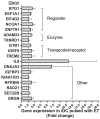Molecular characterization of antigen-peptide pulsed dendritic cells: immature dendritic cells develop a distinct molecular profile when pulsed with antigen peptide
- PMID: 24475103
- PMCID: PMC3903525
- DOI: 10.1371/journal.pone.0086306
Molecular characterization of antigen-peptide pulsed dendritic cells: immature dendritic cells develop a distinct molecular profile when pulsed with antigen peptide
Abstract
As dendritic cells (DCs) are the most potent professional antigen-presenting cells, they are being tested as cancer vaccines for immunotherapy of established cancers. Although numerous studies have characterized DCs by their phenotype and function, few have identified potential molecular markers of antigen presentation prior to vaccination of host. In this study we generated pre-immature DC (piDC), immature DC (iDC), and mature DC (mDC) from human peripheral blood monocytes (PBMC) obtained from HLA-A2 healthy donors, and pulsed them with human papillomavirus E7 peptide (p11-20), a class I HLA-A2 binding antigen. We then characterized DCs for cell surface phenotype and gene expression profile by microarray technology. We identified a set of 59 genes that distinguished three differentiation stages of DCs (piDC, iDC and mDC). When piDC, iDC and mDC were pulsed with E7 peptide for 2 hrs, the surface phenotype did not change, however, iDCs rather than mDCs showed transcriptional response by up-regulation of a set of genes. A total of 52 genes were modulated in iDC upon antigen pulsing. Elongation of pulse time for iDCs to 10 and 24 hrs did not significantly bring further changes in gene expression. The E7 peptide up-modulated immune response (KPNA7, IGSF6, NCR3, TREM2, TUBAL3, IL8, NFKBIA), pro-apoptosis (BTG1, SEMA6A, IGFBP3 and SRGN), anti-apoptosis (NFKBIA), DNA repair (MRPS11, RAD21, TXNRD1), and cell adhesion and cell migration genes (EPHA1, PGF, IL8 and CYR61) in iDCs. We confirmed our results by Q-PCR analysis. The E7 peptide but not control peptide (PADRE) induced up-regulation of NFKB1A gene only in HLA-A2 positive iDCs and not in HLA-A2 negative iDCs. These results suggest that E7 up-regulation of genes is specific and HLA restricted and that these genes may represent markers of antigen presentation and help rapidly assess the quality of dendritic cells prior to administration to the host.
Conflict of interest statement
Figures




Similar articles
-
Expression of CD56 by human papillomavirus E7-specific CD8+ cytotoxic T lymphocytes correlates with increased intracellular perforin expression and enhanced cytotoxicity against HLA-A2-matched cervical tumor cells.Clin Cancer Res. 2001 Mar;7(3 Suppl):804s-810s. Clin Cancer Res. 2001. PMID: 11300476
-
Levels of antigen processing machinery components in dendritic cells generated for vaccination of HIV-1+ subjects.AIDS. 2007 Aug 20;21(13):1683-92. doi: 10.1097/QAD.0b013e32825eabbc. AIDS. 2007. PMID: 17690565
-
Dendritic cells infected with a vaccinia vector carrying the human gp100 gene simultaneously present multiple specificities and elicit high-affinity T cells reactive to multiple epitopes and restricted by HLA-A2 and -A3.J Immunol. 2000 Apr 15;164(8):4204-11. doi: 10.4049/jimmunol.164.8.4204. J Immunol. 2000. PMID: 10754316
-
Generation of tumor-specific cytotoxic T lymphocytes by stimulation with HPV type 16 E7 peptide-pulsed dendritic cells: an approach to immunotherapy of cervical cancer.Gynecol Oncol. 1999 Sep;74(3):448-55. doi: 10.1006/gyno.1999.5504. Gynecol Oncol. 1999. PMID: 10479508
-
Transcriptome of hypoxic immature dendritic cells: modulation of chemokine/receptor expression.Mol Cancer Res. 2008 Feb;6(2):175-85. doi: 10.1158/1541-7786.MCR-07-0391. Mol Cancer Res. 2008. PMID: 18314479
Cited by
-
Distinct single-component adjuvants steer human DC-mediated T-cell polarization via Toll-like receptor signaling toward a potent antiviral immune response.Proc Natl Acad Sci U S A. 2021 Sep 28;118(39):e2103651118. doi: 10.1073/pnas.2103651118. Proc Natl Acad Sci U S A. 2021. PMID: 34561306 Free PMC article.
-
MicroRNA and mRNA expression associated with ectopic germinal centers in thymus of myasthenia gravis.PLoS One. 2018 Oct 11;13(10):e0205464. doi: 10.1371/journal.pone.0205464. eCollection 2018. PLoS One. 2018. PMID: 30308012 Free PMC article.
-
Culture and Identification of Mouse Bone Marrow-Derived Dendritic Cells and Their Capability to Induce T Lymphocyte Proliferation.Med Sci Monit. 2016 Jan 23;22:244-50. doi: 10.12659/msm.896951. Med Sci Monit. 2016. PMID: 26802068 Free PMC article.
-
Inhibition of IL1R1 or CASP4 attenuates spinal cord injury through ameliorating NLRP3 inflammasome-induced pyroptosis.Front Immunol. 2022 Aug 5;13:963582. doi: 10.3389/fimmu.2022.963582. eCollection 2022. Front Immunol. 2022. PMID: 35990672 Free PMC article.
-
Development of dendritic cell loaded MAGE-A2 long peptide; a potential target for tumor-specific T cell-mediated prostate cancer immunotherapy.Cancer Cell Int. 2023 Nov 11;23(1):270. doi: 10.1186/s12935-023-03108-0. Cancer Cell Int. 2023. PMID: 37951911 Free PMC article.
References
-
- Banchereau J, Steinman RM (1998) Dendritic cells and the control of immunity. Nature 392: 245–252. - PubMed
-
- Soumelis V, Liu YJ (2006) From plasmacytoid to dendritic cell: morphological and functional switches during plasmacytoid pre-dendritic cell differentiation. Eur J Immunol 36: 2286–2292. - PubMed
-
- Banchereau J, Palucka AK (2005) Dendritic cells as therapeutic vaccines against cancer. Nat Rev Immunol 5: 296–306. - PubMed
MeSH terms
Substances
LinkOut - more resources
Full Text Sources
Other Literature Sources
Research Materials
Miscellaneous

